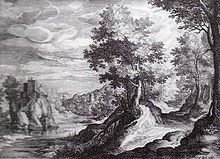Garland with landscape

Juan van der Hamen y León , 1628
85 cm × 107 cm
Oil on canvas
Hood Museum , Dartmouth College , Hanover, NH
Garland with Landscape is the title of two paintings by the Spanish painter Juan van der Hamen y León from 1628. The two 85 cm × 107 cm paintings, paintedin oil on canvas , were created at the same time and share all of their stages of development. They are an experiment by van der Hamen with the connection of still life elements with other pictorial genres and represent the introduction of the garland into Spanish painting. Both paintings went through an eventful history with many changes and are now in restored versions in the Hood Museum , Dartmouth College , Hanover, NH and at the Meadows Museum , Southern Methodist University , Dallas .
description
Both paintings show a wreath composed of various flowers that surrounds a landscape. Some of the flowers used in the wreaths are sunflower , viburnum , peonies, and lilies . The landscape in the image of the Hood Museum shows a river landscape that is flooded with light. Across the river is a village dominated by rugged cliffs. On this side of the river, a pilgrim kneels in front of a statue of a saint. The right half of the picture, which would show the foreground of the landscape, has not been preserved and was painted over in a dark, earthy shade of brown. The painting in the Meadows Museum shows a mountainous landscape with a castle complex. The foreground was painted over in brown as well as on the counterpart. The backgrounds of the landscapes in both pictures are painted with heavy use of white lead , the foregrounds are based on earth colors.
background


The two garlands with landscape were an attempt by Juan van der Hamen y León to combine still life with other genres. He introduced the motif of the garland into Spanish painting, the section of which had to be filled with motifs. This experiment can be traced back to the various stages of development of the paintings, which also show that both paintings were conceived as a pair from the start. The two flower wreaths show only a few pentimenti , but the enclosed picture surface was subjected to major changes by van der Hamen. In the X-ray examination, two more can be seen among the final landscape motifs. These major changes suggest that Juan van der Hamen was looking for the right pictorial strategy.
Originally, two female saints were supposed to fill the wreaths. Their bodies are twisted and their heads are tilted and pointing in opposite directions. This system confirmed that the plans had already involved a pair of images. The Hood Museum picture shows a saint with the Christ child . At its feet are a crown of thorns and the part of a wheel that perhaps refers to Saint Catherine of Alexandria . The saint of the painting in the Meadows Museum holds an unidentifiable object in her hands, so that no statement can be made about her identification. It is not known why Jan van der Hamen rejected this pictorial solution, but he painted over the saints with a thin layer of gray paint on which he then applied new motifs.
The second motifs tried were scenes from the Old Testament . The painting in Dartmouth showed the crossing of the Red Sea as a multi-figured scene with Egyptian horsemen and foot soldiers lapped by the waves and Moses pointing towards the promised land. The painting in the Meadows Museum showed the triumph of David after an engraving by Antonio Tempesta . David rides a horse with a long broadsword while the head of Goliath is presented by a soldier. The two dancers, one with a tambourine, can be seen in the X-ray. Juan van der Hamen repainted these motifs with a primer on which he then applied the two landscapes.
For the final version of the picture, van der Hamen took inspiration from landscapes such as those painted by Paul Bril in Rome and which were popularized through engravings by Johan Sadeler I and his family, some of which Juan van der Hamen y León owned. These were characterized by a split with a close view of a forest path and a distant view of a river, mountains and buildings. Juan van der Hamen painted the dark foreground with earthy colors, while the backgrounds were painted with a larger use of white lead. Over time, both paintings were badly damaged by improper restorations. The condition in the 1960s, when they were acquired for the American museums, showed 60 percent overpainting. Most of the earth colors have been lost, which is why the foregrounds were painted over dark after the restoration because the underlying layer of the history paintings shone through. However, the landscapes in the background have been preserved relatively well and have been restored.
- Garland with landscape, Hood Museum
literature
- William B. Jordan : Juan van der Hamen y León & The Court of Madrid . Yale University Press, New Haven 2005. ISBN 0-300-11318-8 .
- Ira Oppermann: The Spanish Still Life in the 17th Century. From the windowless room to the light-flooded landscape . Reimer, Berlin 2007. ISBN 978-3496013686 .






